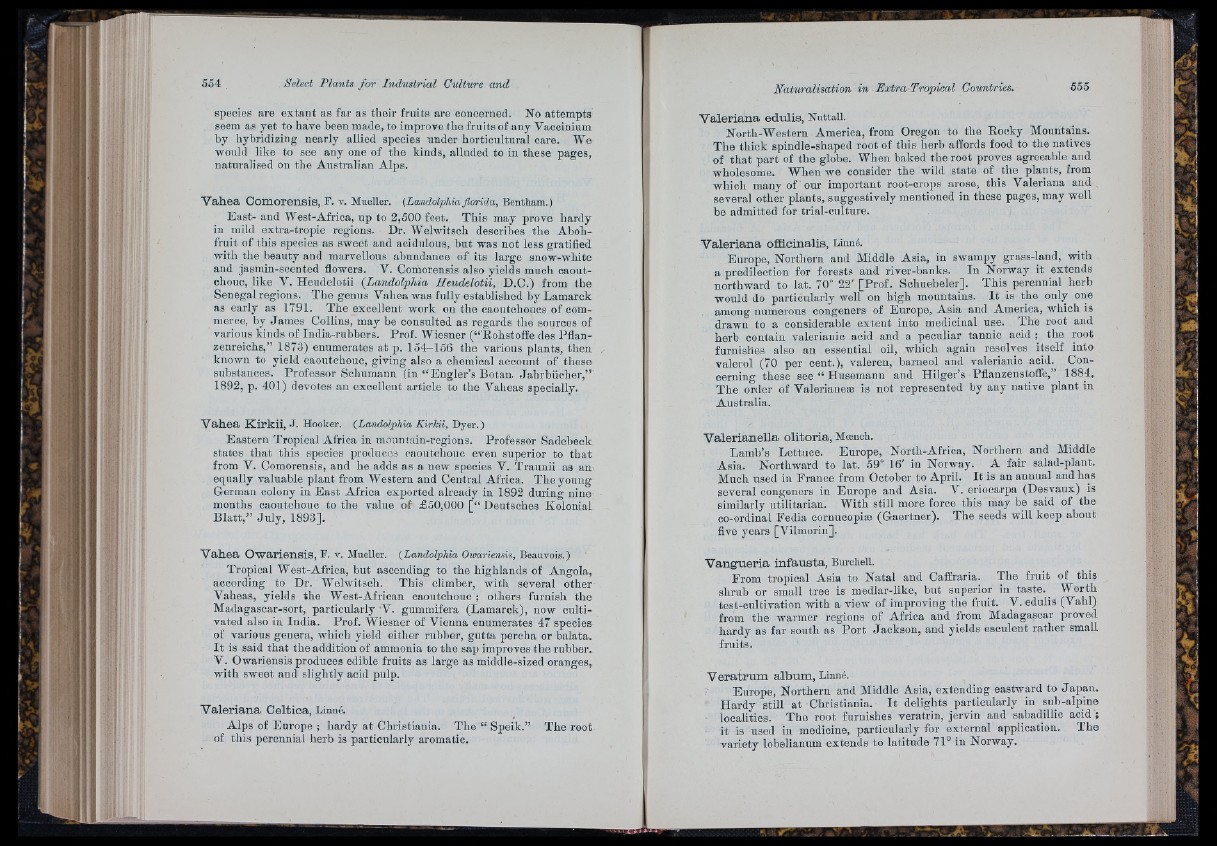
554
species are extant as far as their fruits are concerned. No attempts
seem as yet to have been made, to improve the fruits of any Vaccinium
by hybridizing nearly allied species under horticultural care. We
would like to see any one of the kinds, alluded to in these pages,
naturalised on tlie Australian Alps.
Vahea Comorensis, F. V. Mueller. (Landolphiaflorida, Bentham.)
East- and West-Africa, up to 2,500 feet. This may prove hardy
ill mild extra-tropio regions. Dr. Welwitsch describes the Aboh-
fruit of this species as sweet and aoidnlous, but was not less gratified
with the beauty and marvellous abundance of its large snow-white
and jasmin-scented flowers. V. Comorensis also yields much caoutchouc,
like V. Heudelotii {landolphia Heudelotii, D.C.) from the
Senegal regions. The genus Vahea was fully established by Lamarck
as early as 1791. The excellent work on the caoutchoucs of commerce,
by James Collins, may be consulted as regards the sources of
various kinds of India-rubbers. Prof. Wiesner (“'Eohstofle des Pflanzenreichs,”
1873) enumerates at p. 154—156 the various plants, then
known to yield caoutchouc, giving also a chemical account of these
substances. Professor Schumann (iu “ Engler’s Botan. Jahrbücher,”
1892, p. 401) devotes an excellent article to the Vaheas specially.
Vahea Kiriîii, J. Hooker. {Landolphia Kirldi, Dyer.)
Eastern Tropical Africa in mountain-regions. Professor Sadebeck
states th a t this species produces caoutchouc even superior to th a t
from V. Comorensis, and he adds as a new species V. Trauuii as an
equally valuable plant from Western and Central Africa. The young
German colony in East Africa exported already iu 1892 during nine
months caoutchouc to the value of £50,000 [ “ Deutsches Kolonial
B la tt,” Ju ly , 1893].
Vahea Owariensis, F. v. Mueller. {Landolphia Owariensis, Beauvois.)
Tropical West-Africa, but ascending to the highlands of Angola,
according to Dr. Welwitsch. This climber, with several other
Vaheas, yields the West-African caoutchouc ; others furnish the
Madagasear-sort, particularly V . gummifera (Lamarck), now cultivated
also in India. Prof. Wiesner of Vienna enumerates 47 species
of various genera, which yield either rubber, gutta pereha or balata.
I t is said th a t the addition of ammonia to the sap improves the rubber.
V. Owariensis produces edible fruits as large as middle-sized oranges,
with sweet and slightly acid pulp.
Valeriana Celtica, Linné.
Alps of Europe ; hardy a t Christiania. The “ Speik.”
of this perennial herb is particularly aromatic.
The root
Valeriana edulis, Nuttall.
North-Western America, from Oregon to the Rocky Mountains.
The thick spindle-shaped root of this herb affords food to the natives
of th a t part of the globe. When baked the root proves agreeable and
wholesome. W^hen we consider the wild state of the plants, from
which many of our important root-crops arose, this Valeriana and
several other plants, suggestively mentioned in these pages, may well
be admitted for trial-culture.
Valeriana oflflcinalis, Linné.
Europe, Northern and Middle Asia, in swampy grass-land, with
a predilection for forests and river-banks. In Norway it extends
northward to lat. 70° 22' [Pro f. Schuebeler], This perennial herb
would do particularly well on high mountains. I t is the only one
among numerous congeners of Europe, Asia and America, which is
drawn to a considerable extent into medicinal use. The root and
herb contain valerianic acid and a peculiar tannic acid ; the root
furnishes also an essential oil, which again resolves itself into
valerol (70 per cent.), valeren, barneol and valerianic acid. Concerning
these see “ Husemann and Hilger’s Pflanzenstofle,” 1884.
The order of Valerianeæ is not represented by any native plant in
Australia.
Valerianella olitoria, Moench.
Lamb’s Lettuce. Europe, North-Africa, Northern and Middle
Asia. Northward to lat. 59° 16' in Norway. A fair salad-plant.
Much used in France from October to April. I t is an annual and has
several congeners in Europe and Asia. V. eriocarpa (Desvaux) is
similarly utilitarian. With still more force this may he said of the
co-ordinal Fedia cornueopiæ (Gaertner). The seeds will keep ahout
five years [Vilmorin].
Vang-ueria infausta, Burchell.
From tropical Asia to Natal and Caffraria. The fruit of this
shrub or small tree is medlar-like, but superior iu taste. Worth
test-oultivation with a view of improving the fruit. V. edulis (Vahl)
from the warmer regions of Africa and from Madagascar proved
hardy as far south as P o rt Jackson, and yields esculent rather small
fruits.
Veratrum album, Linné.
Europe, Northern and Middle Asia, extending eastward to Jap an .
Hardy still at Christiania. I t delights partioularly in sub-alpine
localities. The root furnishes veratrin, jervin and sabadillic acid ;
it is used in medicine, particularly for external application. The
variety lobelianum extends to latitude 71° in Norway.